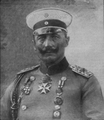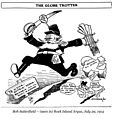July Ultimatum facts for kids
The July Ultimatum was a Demarche issued by Austria-Hungary to the Royal Serbian Government at 6 pm on 23 July 1914, after the Assassination of Archduke Franz Ferdinand of Austria.
Austria-Hungary's government did not directly accuse Serbia for the assassination but for "doing nothing to suppress" the subversive anti-Austro-Hungarian movement in Serbia which grew beyond Serbia's borders and which was responsible for acts of terrorism, assassination attempts and murders.
Serbia refused to accept one of the ten items of the ultimatum, and so Austria-Hungary mobilized their army. This, along with a chain of Alliances in Europe (Triple Entente and Central Powers) helped cause World War I.
The Ultimatum Requests
The Ultimatum requested Serbia to pledge itself for the following:
- to suppress every publication which shall incite to hatred and contempt of the Monarchy, and the general tendency of which shall be directed against the territorial integrity of the latter;
- to proceed at once to the dissolution of the Narodna Odbrana to confiscate all of its means of propaganda, and in the same manner to proceed against the other unions and associations in Serbia which occupy themselves with propaganda against Austria-Hungary; the Royal Government will take such measures as are necessary to make sure that the dissolved associations may not continue their activities under other names or in other forms;
- to eliminate without delay from public instruction in Serbia, everything, whether connected with the teaching corps or with the methods of teaching, that serves or may serve to nourish the propaganda against Austria-Hungary;
- to remove from the military and administrative service in general all officers and officials who have been guilty of carrying on the propaganda against Austria-Hungary, whose names the Imperial and Royal Government reserves the right to make known to the Royal Government when communicating the material evidence now in its possession;
- to agree to the cooperation in Serbia of the organs of the Imperial and Royal Government in the suppression of the subversive movement directed against the integrity of the Monarchy;
- to institute a judicial inquiry against every participant in the conspiracy of the twenty-eighth of June who may be found in Serbian territory; the organs of the Imperial and Royal Government delegated for this purpose will take part in the proceedings held for this purpose;
- to undertake with all haste the arrest of Major Voislav Tankosic and of one Milan Ciganovitch, a Serbian official, who have been compromised by the results of the inquiry;
- by efficient measures to prevent the participation of Serbian authorities in the smuggling of weapons and explosives across the frontier; to dismiss from the service and to punish severely those members of the Frontier Service at Schabats and Losnitza who assisted the authors of the crime of Sarajevo to cross the frontier;
- to make explanations to the Imperial and Royal Government concerning the unjustifiable utterances of high Serbian functionaries in Serbia and abroad, who, without regard for their official position, have not hesitated to express themselves in a manner hostile toward Austria-Hungary since the assassination of the twenty-eighth of June;
- to inform the Imperial and Royal Government without delay of the execution of the measures comprised in the foregoing points.
The Russian Memorandum of Advice to Serbia
The Russia asked Austria-Hungaria to extend the ultimatum deadline which would allow the Governments of the Great Powers to become acquainted with and to investigate the documents on the Sarajevo crime.
Images for kids
-
Political cartoon titled "Der Stänker" ("The Troublemaker"), published in the German satirical magazine Kladderadatsch on 9 August 1914, depicting the nations of Europe sitting at a table.(1st panel) The Central Powers hold their noses in distaste as tiny Serbia joins the table, while Russia reacts with joy.(2) Serbia stabs Austria-Hungary, to everyone's apparent shock. Germany immediately offers support to Austria.(3) Austria demands satisfaction from Serbia, while a relaxed Germany with hands in its pockets does not notice Russia and France come to agreement in the background.(4) Austria manhandles Serbia, while an alarmed Germany looks to an angry Russia and presumably makes an agreement with the Ottoman Empire, and France tries to talk to Britain.(5) A general brawl erupts with Germany and France immediately confronting each other, as Britain looks on in dismay. To the right, another combatant threatens to join from the darkness, possibly Japan.
-
Dragutin Dimitrijević, leader of the Black Hand and prominent member of the Serbian General Staff.
-
Wilhelm II of Germany was known for his impetuous personality, described by one scholar as "not lacking in intelligence, but he did lack stability, disguising his deep insecurities by swagger and tough talk."
-
Count Franz Conrad von Hötzendorf, Chief of the General Staff of the Austro-Hungarian Army from 1906 to 1917, determined the earliest that Austria could declare war was 25 July.
-
Map of the Kingdom of Serbia in 1913
-
Non-commissioned officers of the Imperial Russian Army, 24 July 1914
-
Cartoon titled "The Globe Trotter" in U.S. newspaper Rock Island Argus on 29 July 1914 depicting "General War Scare" running from resolved U.S.-Mexico tension to "all points in Europe"
-
Vladimir Sukhomlinov, Minister of War of the Russian Empire, insisted a partial mobilization was impossible for Russia.
-
British satirical magazine Punch depicted Belgium as a scrappy youth blocking the passage of elderly, bullying Germany, August 1914
















